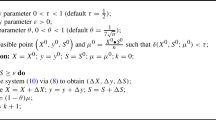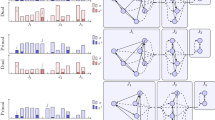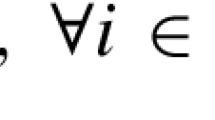Abstract
We propose a primal-dual “layered-step” interior point (LIP) algorithm for linear programming with data given by real numbers. This algorithm follows the central path, either with short steps or with a new type of step called a “layered least squares” (LLS) step. The algorithm returns an exact optimum after a finite number of steps—in particular, after O(n 3.5 c(A)) iterations, wherec(A) is a function of the coefficient matrix. The LLS steps can be thought of as accelerating a classical path-following interior point method. One consequence of the new method is a new characterization of the central path: we show that it composed of at mostn 2 alternating straight and curved segments. If the LIP algorithm is applied to integer data, we get as another corollary a new proof of a well-known theorem by Tardos that linear programming can be solved in strongly polynomial time provided thatA contains small-integer entries.
Similar content being viewed by others
References
R. K. Ahuja, T. L. Magnanti and J. B. Orlin,Network Flows: Theory, Algorithms, and Applications (Prentice-Hall, Englewood Cliffs, New Jersey, 1993).
D. A. Bayer and J. C. Lagarias, The nonlinear geometry of linear programming. I. Affine and projective scaling trajectories,Transactions of the AMS 314 (1989) 499–526.
D. A. Bayer and J. C. Lagaria, The nonlinear geometry of linear programming, II. Legendre transform coordinates and central trajectories,Transactions of the AMS 314 (1989) 527–581.
D. A. Bayer and J. C. Lagarias, The nonlinear geometry of linear programming. III. Projective Legendre transform coordinates and Hilbert geometry,Transactions of the AMS 320 (1990) 193–225.
A. Ben-Tal and M. Teboulle, A geometric property of the least squares solutions of linear equations,Linear Algebra and Its Applications 139 (1990) 165–170.
T. Coleman, Large-scale numerical optimization: introduction and overview, in: A. Kent and J. G. Williams, eds.,Encyclopedia of Computer Science and Technology 28 (Marcel Dekker, New York, 1993) 167–195.
J. Edmonds, Systems of distinct representatives and linear algebra,Journal of Research of the National Bureau of Standards 71B (1967) 241–245.
A. Forsgren, On linear least-squares problems with diagnonally dominant weight matrices, Technical Report TRITA-MAT-1995-OS2, Department of Mathematics, Royal Institute of Technology, Stockholm, Sweden.
G. H. Golub and C. F. V. Loan,Matrix Computations, 2nd edn. (Johns Hopkins University Press, Baltimore, 1989)
C. C. Gonzaga, Path-following methods for linear programming,SIAM Review 34 (1992) 167–224.
J. A. Kaliski and Y. Ye, A short-cut potential reduction algorithm for linear programming,Management Science 39 (1993) 757–773.
N. Karmarkar, A new polynomial-time algorithm for linear programming,Combinatorica 4 (1984) 373–395.
L. Khachiyan, On the complexity of approximating extremal determinants in matrices, Preprint (1994).
L. G. Khachiyan. A polynomial algorithm in linear programming,Doklady Akademii Nauk SSSR 244 (1979) 1093–1086 (translated inSoviet Math. Dokl. 20 (1979) 191–194).
M. Kojima, S. Mizuno and A. Yoshise, A polynomial-time algorithm for a class of linear complementarity problems,Mathematical Programming 44 (1989) 1–26.
I. J. Lustig, R. E. Marsten and D. F. Shanno, Computational experience with a primal-dual interior point method for linear programming,Linear Algebra and Its Applications 152 (1991) 191–222.
L. McLinden, An analogue of Moreau's proximation theorem, with applications to the nonlinear complementarity problem.Pacific Journal of Mathematics 88 (1980) 101–161.
N. Megiddo, Pathways to the optimal set in linear programming, in: N. Megiddo, ed.,Progress in Mathematical Programming: Interior Point and Related Method (Springer, New York, 1989) 131–158.
N. Megiddo and M. Shub, Boundary behavior of interior point algorithms in linear programming,Mathematics of Operations Research 14 (1989) 97–146.
S. Mizuno, M.J. Todd and Y. Ye, On adaptive-step primal-dual interior-point algorithms for linear programming,Mathematics of Operations Research 18 (1993) 964–981.
S. Mizuno, M.J. Todd and Y. Ye, A surface of analytic centers and infeasible interior-point algorithms for linear programming,Mathematics of Operations Research 20 (1995) 135–162.
R. C. Monteiro and I. Adler, Interior path following primal-dual algorithm. Part I: linear programming,Mathematical Programming 44 (1989) 27–41.
Y. Nesterov and A. Nemirovskii,Interior Point Polynomial Methods in Convex Programming: Theory and Algorithms, SIAM Studies in Applied Mathematics 13 (SIAM, Philadelphia, 1994).
D. P. O'Leary, On bounds for scaled projections and pseudoinverses,Linear Algebra and Its Applications 132 (1990) 115–117.
J. B. Orlin, A faster strongly polynomial minimum cost flow algorithm, in:Proceedings 20th ACM Symposium on the Theory of Computing (1988) 277–388.
C. H. Papadimitriou and K. Steiglitz,Combinatorial Optimization: Algorithms and Complexity (Prentice Hall, Englewood Cliff, NJ, 1982).
J. Renegar, A polynomial-time algorithm based on Newton's method for linear programming.Mathematical Programming 40 (1988) 59–94.
J. Renegar, Linear Programming, Complexity Theory, and Elementary Functional Analysis, unpublished manuscript, Department of Operations Research and Industrial Engineering, Cornell University (1993).
M. G. C. Resende and G. Veiga, An efficient implementation of a network interior point method, Technical report, Mathematical Sciences Research Center, AT & T Bell Laboratories, Murray Hill, NJ 07974-0636, USA (1992). Revised March 1992, revised version 2.0 August 1992 (to appear inDIMACS Series in Discrete Mathematics and Theoretical Computer Science).
G. Sonnevend, An ‘analytic center’ for polyhedrons and new classes of global algorithms for linear (smooth, convex) programming, in: A. Prekopa, J. Szelezsan and B. Strazicky, eds.,System Modelling and Optimization: Proceedings of the 12th IFIP Conference, Budapest, Hungary (1985). Lecture Notes in Control and Information Sciences. 84 (Springer Verlag, Berlin, Germany, 1986) 866–876.
G. Sonnevend, J. Stoer and G. Zhao. On the complexity of following the central path of linear programs by linear extrapolation II,Mathematical Programming 52 (1991) 527–553.
G. W. Stewart, On scaled projections and pseudoinverses,Linear Algebra and Its Applications 112 (1989) 189–193.
E. Tardos, A strongly polynomial algorithm to solve combinatorial linear programs,Operations Research 34 (1986) 250–256.
M. J. Todd, A Dantzig-Wolfe-like variant of Karmarkar's interior-point linear programming algorithm,Operations Research 38 (1990) 1006–1018.
K. Tone, An active-set strategy in an interior point method for linear programming,Mathematical Programming 59 (1993) 345–360.
L. Tuncel, A pseudo-polynomial complexity analysis for interior-point algorithms. Technical Report CORR 93-16, Department of Combinatorics and Optimization, University of Waterloo, Waterloo, Ontario, Canada (1993).
S. A. Vavasis,Nonlinear Optimization: Complexity Issues (Oxford University Press, New York, 1991).
S. A. Vavasis, Stable finite elements for problems with wild coefficients, Technical Report 93-1364, Department of Computer Science, Cornell University, Ithaca, NY (1993) (to appear inSIAM Journal on Numerical Analysis).
S. A. Vavasis, Stable numerical algorithms for equilibrium systems,SIAM Journal on Matrix Analysis and Applications 15 (1994) 1108–1131.
S. A. Vavasis and Y. Ye, Condition numbers for polyhedra with real number data,Operations Research Letters 17 (1995) 209–214.
M. H. Wright, Numerical methods for nonlinearly constrained optimization, Ph. D. Thesis, Stanford University (1976).
M. H. Wright, Interior methods for constrained optimization, in: A. Iserles, ed.,Acta Numerica 1992 (Cambridge University Press, Cambridge, 1992) 341–407.
Y. Ye, On the finite convergence of interior-point algorithms for linear programming,Mathematical Programming 57 (1992) 325–336.
Y. Ye O. Güler, R. A. Tapia and Y. Zhang, A quadratically convergent\(O(\sqrt n L)\)-iteration algorithm for linear programming,Mathematical Programming 59 (1993) 151–162.
Author information
Authors and Affiliations
Corresponding author
Additional information
This paper represents a simplification of an earlier manuscript “An accelerated interior point method whose running time depends only onA” by the same authors.
This work is supported in part by the National Science Foundation, the Air Force Office of Scientific Research, and the Office of Naval Research, through NSF grant DMS-8920550. Also supported in part by an NSF Presidential Young Investigator award with matching funds received from AT&T and Xerox Corp. Part of this work was done while the author was visiting Sandia National Laboratories, supported by the U.S. Department of Energy under contract DE-AC04-76DP00789.
This author is supported in part by NSF Grant DDM-9207347. Part of this work was done while the author was on a sabbatical leave from the University of Iowa and visiting the Cornell Theory Center, Cornell University, Ithaca, NY 14853, supported in part by the Cornell Center for Applied Mathematics and by the Advanced Computing Research Institute, a unit of the Cornell Theory Center, which receives major funding from the National Science Foundation and IBM Corporation, with additional support from New York State and members of its Corporate Research Institute. E-mail: yyye@col.biz.uiowa.edu.
Rights and permissions
About this article
Cite this article
Vavasis, S.A., Ye, Y. A primal-dual interior point method whose running time depends only on the constraint matrix. Mathematical Programming 74, 79–120 (1996). https://doi.org/10.1007/BF02592148
Received:
Revised:
Issue Date:
DOI: https://doi.org/10.1007/BF02592148




